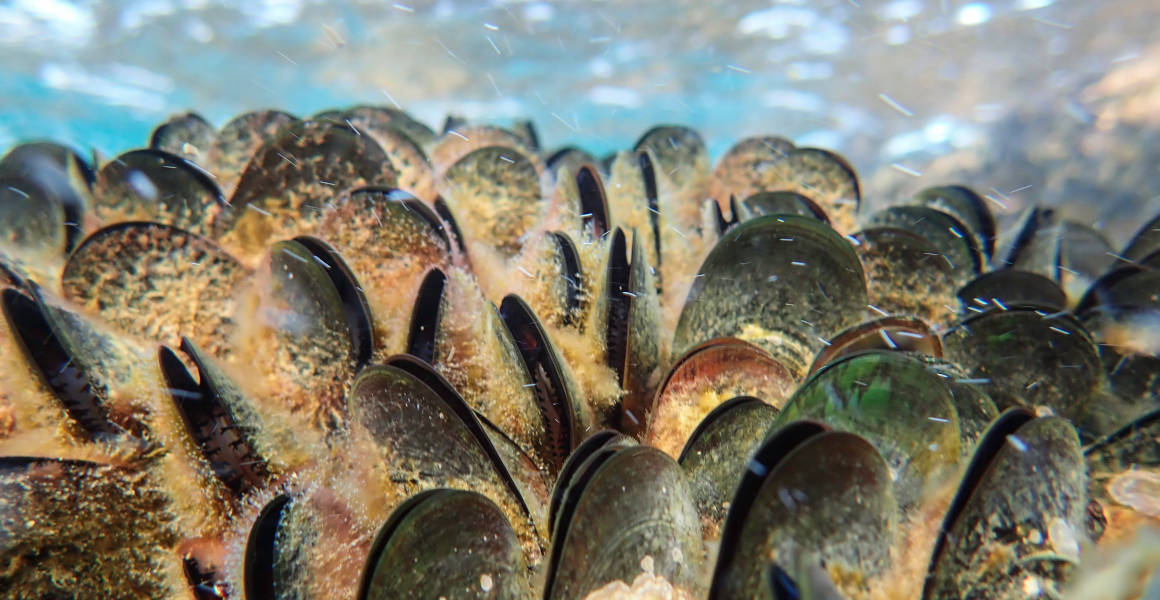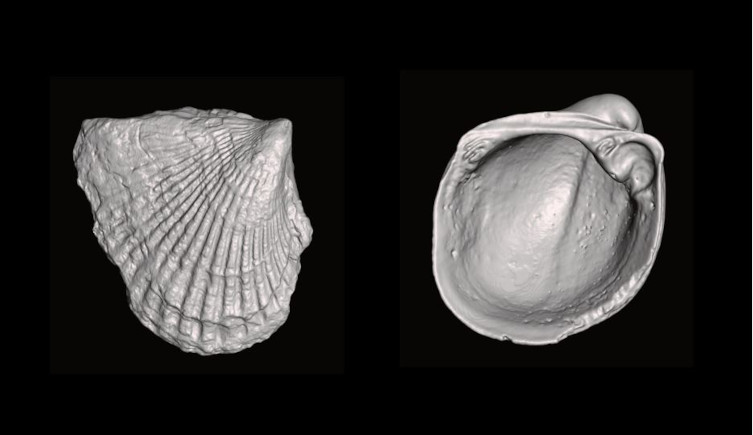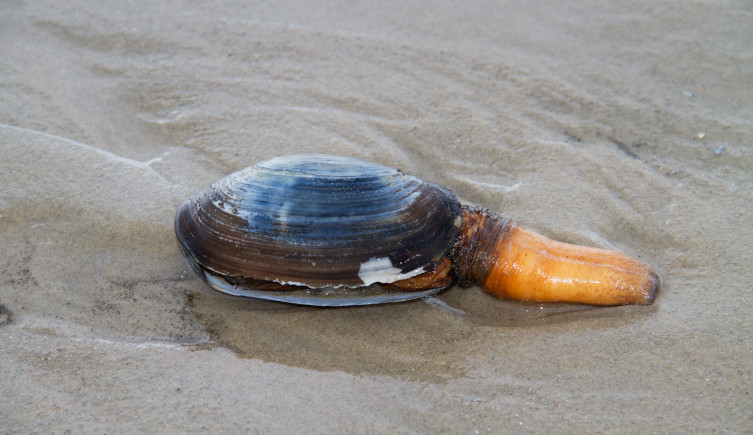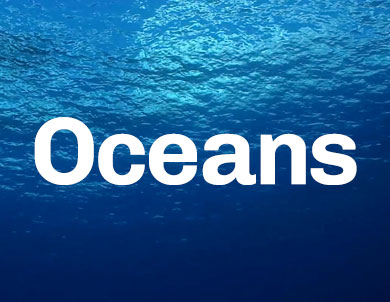The early evolution of clams, oysters and scallops have been revealed in a new study.
While there are thousands of bivalve species alive today, the group was slow to evolve new members while other animals rushed ahead.

There are around 6,500 living species of bivalve, such as mussels, with thousands more extinct species. Image © boulham/Shutterstock.
The early evolution of clams, oysters and scallops have been revealed in a new study.
While there are thousands of bivalve species alive today, the group was slow to evolve new members while other animals rushed ahead.
The bivalves appear to have been left behind in history’s biggest ever burst of evolution.
Over 500 million years ago, the Cambrian explosion was a period of time when most of the major groups of animals first evolved. Key characteristics such as hard skeletons and eyes first appear during this time, spurring the development of an increasing number of body plans and lifestyles.
For bivalves, however, this doesn’t appear to have been the case. A new study found that while these animals existed during the Cambrian explosion, their evolution lagged behind the rest of the animal kingdom.
Dr Katie Collins, the Museum’s Curator of Benthic Molluscs and a co-author of the research, says, ‘The Cambrian explosion is a major turning point for other groups of animals, but it seems that the bivalves didn’t explode at all.’
‘Instead, it really seems like early bivalves were late to the party, bringing a cheap bottle of wine and hanging out in the kitchen until it was over. They accumulated new bivalve species gradually over time.’
The findings of the study were published in the journal Biology Letters.

The 460-million-year-old bivalves Anomalodonta (left) and Vanuxemia (right) come from the Ordovician Period, a time when bivalve evolution began to pick up. Image © Stewart Edie.
As with many animal groups, the first bivalves originated in the Early Cambrian. They are thought to have evolved from ancestors which gradually saw their head reduced over time as they developed a hinged shell.
Two of the best-known groups of these early species are Fordilla and Pojetaia, which have been found in Australian and Russian rocks. Despite their small size and fragility, preserved imprints of the inside of the shell have allowed researchers to learn more about what these animals were like.
‘Fossil-bearing rocks from the Early Cambrian are not common, as a lot of them have been metamorphosed into other rock types so any fossils they had have been lost,’ Katie explains.
‘Where they have survived, they are difficult to find and identify as they measure only a few millimetres in size, and often lack features that clearly mark them out as bivalves.’
‘Genera like Fordilla and Pojetaia, however, have characteristics such as tiny teeth and muscle scars which prove they’re bivalves.’
Unlike modern bivalves, however, Fordilla has muscle scars on its interior that suggest the muscular foot which it used for movement emerged from its underside, rather than the front of the shell. An front-facing foot is associated with burrowing, meaning that Fordilla likely could not burrow, or could only do so very shallowly.
This might relate to the different environment of the seas in the Early Cambrian, when the ocean floor was dominated by microbial mats rather than soft sediment layers that could be burrowed into.
But eventually this underwater environment began to change, as factors such as rising nutrient levels helped to kick off the Cambrian explosion. While other groups, such as the trilobites, rapidly diversified into thousands of new species, the bivalves appear to have remained very much the same.
Across their first 40 million years of evolution, only four genera of bivalves are known. While it’s possible that other Cambrian bivalves may not have been preserved, the otherwise widespread distribution of their fossils, and the relative abundance of other shelled mollusc fossils from this time, suggests that bivalves just weren’t a very diverse group.
To get an even closer insight into the early years of bivalves, the researchers have examined bivalve fossils from across 80 million years of their evolution from the Cambrian into the following Ordovician Period.

The bivalve siphon allowed them to occupy a range of new habitats. Image © Matauw/Shutterstock.
The researchers found that unlike other animals in the Cambrian, the bivalves don’t appear to have become much more diverse. Neither the number of genera, or ecosystem roles they could perform, increased significantly in their first 36 million years.
Professor David Jablonski, a co-author on the paper, says, ‘While you might think that the bivalves would take immediate advantage and go on to fame and biological fortune, we found that they didn’t.’
‘It’s kind of amazing they made it through at all. Even after they got their act together, they never showed a true explosion in species or ecologies.’
Part of the lag in bivalve evolution has been blamed on an extinction event in the Late Cambrian, which reduced the bivalves from a group with a worldwide distribution to one that lived solely in certain habitats of the supercontinent Gondwana.
The study suggests that this might have impeded the evolution of features that would have allowed them to move beyond their Gondwanan home. Instead, their specialisation meant they were stuck living on the border between the seafloor and seawater, where the demands of the environment meant that only a few body shapes could survive.
It was only when new features allowed them to branch out beyond this niche that bivalve evolution began to really get going.
‘One key characteristic that held back the bivalves was a lack of a siphon,’ Katie says. ‘The siphon allows them to burrow deep into the sediment, opening up new areas to live as well as helping bivalves avoid predators.’
‘Another key bivalve feature is filter feeding with the gills, a strategy used by the vast majority of these animals. However, the gills probably hadn’t evolved to a large enough size to be as efficient as they are now during the Cambrian.’
It was only in the Early Ordovician around 480 million years ago that bivalve evolution began to pick up. While it wasn’t as big a burst of evolution as the Cambrian explosion, the Great Ordovician Biodiversification Event (GOBE) saw bivalves catch up for lost time.
During this period they went from four genera to 176, as well as establishing the major groups of bivalves that still exist today. These include the pteriomorphs, a group of bivalves that contains oysters, scallops and marine mussels.
An increase in nutrients and a change in ocean sediments during the GOBE would have driven the development of new burrowing and filter-feeding forms that still persist in modern bivalves.
But after around 10 million years, their evolution began to slow down once more. While new genera of bivalves continued to accumulate, they tended to share some overlap with the ecological roles of already existing groups.
With this solid foundation, the bivalves weathered a series of extinctions and crises over the next 400 million years to become one of the most biodiverse groups of subaquatic animals alive today.

Find out more about why we need to protect oceans and read about the pioneering work of our marine scientists.
Don't miss a thing
Receive email updates about our news, science, exhibitions, events, products, services and fundraising activities. We may occasionally include third-party content from our corporate partners and other museums. We will not share your personal details with these third parties. You must be over the age of 13. Privacy notice.
Follow us on social media